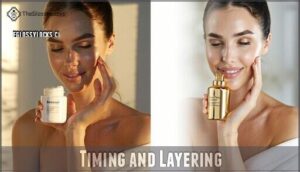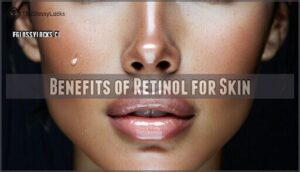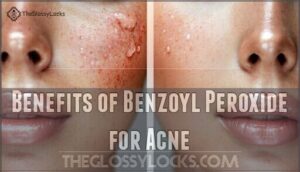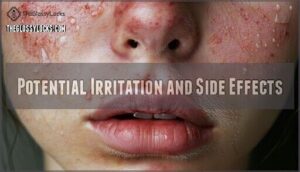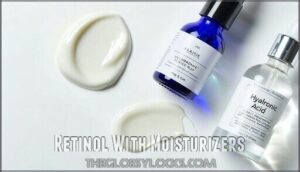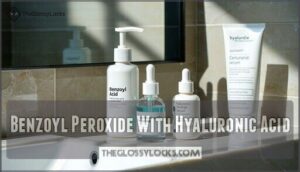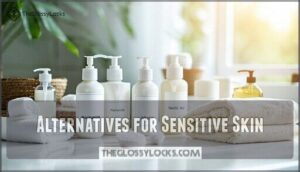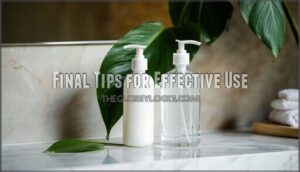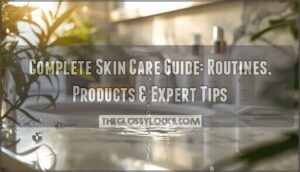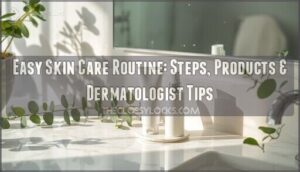This site is supported by our readers. We may earn a commission, at no cost to you, if you purchase through links.

To reap the benefits safely, use benzoyl peroxide in the morning to fight acne and retinol at night to boost cell turnover and collagen.
Always sandwich retinol with a good moisturizer to prevent dryness, and consider products that combine encapsulated retinol with benzoyl peroxide, minimizing conflicts between the two.
Start slowly, introducing one product at a time, and don’t skip sunscreen; it’s your skin’s best friend, and proper timing and layering make all the difference when juggling these powerhouse ingredients!
Table Of Contents
- Key Takeaways
- How to Use Retinol With Benzoyl Peroxide Together?
- Using Retinol and Benzoyl Peroxide Together
- Benefits of Retinol for Skin
- Benefits of Benzoyl Peroxide for Acne
- Potential Irritation and Side Effects
- Best Combinations for Acne
- Alternatives for Sensitive Skin
- Common Mistakes to Avoid
- Final Tips for Effective Use
- Frequently Asked Questions (FAQs)
- Can you use retinol and benzoyl peroxide together?
- Are retinoids better than benzoyl peroxide?
- Does benzoyl peroxide break down retinol?
- Can you use benzoyl peroxide with retinol acne treatment?
- Should I use benzoyl peroxide or retinol at night?
- How often should I use retinol & benzoyl peroxide?
- Can I use retinol and benzoyl peroxide at the same time?
- Does retinol deactivate benzoyl peroxide?
- Do you put retinol on before or after acne cream?
- Can I use benzoyl peroxide in morning and tretinoin at night?
- Conclusion
Key Takeaways
- Use benzoyl peroxide in the morning to fight acne-causing bacteria and retinol at night for skin renewal.
- Start slowly with both products, using them 2–3 times a week, and gradually increase frequency to avoid irritation.
- Always wear sunscreen during the day since both ingredients increase your skin’s sensitivity to sunlight.
- Don’t mix the two products in the same routine; applying them at different times prevents oxidation and maximizes their benefits.
How to Use Retinol With Benzoyl Peroxide Together?
Using retinol and benzoyl peroxide safely isn’t rocket science—it’s all about timing.
Apply benzoyl peroxide in the morning to tackle acne with antibacterial power, then use retinol at night to renew skin without interference.
This avoids oxidation concerns while maximizing benefits.
For sensitive skin, try encapsulated retinol or alternate days.
An adapalene combination might offer effective acne treatment too!
Using Retinol and Benzoyl Peroxide Together
Master the art of clear, glowing skin by using benzoyl peroxide in the morning and retinol at night—timing is everything!
You can use retinol and benzoyl peroxide together, but it takes careful planning to avoid irritation and maximize results.
By understanding timing, layering, and how these ingredients interact, you’ll keep your skin happy and glowing.
Avoiding Chemical Reactions
Balancing benzoyl peroxide and retinol in your skincare routine requires a few smart strategies to sidestep troublesome reactions like retinol degradation or oxidation concerns.
To keep things simple and effective:
- **Apply benzoyl peroxide in the morning and retinol at night.
- **Wait 30 minutes if using both to guarantee formulation stability.
- **Alternate days if skin irritation develops.
Product sequencing matters—sticking to these tips can protect your skin and improve results!
Timing and Layering
Start your morning with benzoyl peroxide—it thrives in daylight and tackles acne-causing bacteria.
Save retinol for your nighttime routine, letting your skin repair and renew.
For maximum product absorption, follow proper layering techniques: lighter formulas first, heavier creams last.
Use a simple rule—wait 30 minutes between actives, if possible.
Combining retinol and benzoyl peroxide may seem tricky, but thoughtful timing guarantees benefits without irritation.
Benefits of Retinol for Skin
Retinol works by boosting your skin’s cell turnover, helping to smooth fine lines, fade dark spots, and refine texture over time.
Boost skin cell turnover, smooth fine lines, fade dark spots, and refine texture with retinol for a radiant, renewed complexion.
It also unclogs pores, making it a powerful ally in preventing breakouts and promoting a clearer complexion.
Anti-Aging Properties
Consistency with retinol reveals impressive antiaging perks. This standout ingredient smooths fine lines and boosts skin elasticity like a fountain of youth trapped in a bottle.
Here’s what retinol does for your skin:
- Stimulates collagen to reduce wrinkles and firm skin
- Improves texture and balances your skin tone
- Speeds up cellular turnover, revealing brighter, fresher skin
- Offers antioxidant benefits, fighting free radicals for a healthy glow
Pair it with benzoyl peroxide in separate routines—morning for acne-fighting, night for retinol. And don’t skip SPF! Healthy skin loves sunlight protection as much as it loves good skincare.
Unclogging Pores
Retinol works wonders for pore cleansing and acne treatment.
By accelerating skin cell turnover, it prevents clogged pores, tackling the buildup that leads to blackheads and whiteheads.
Think of it as a cleanup crew for your skin, reducing pore size and refining texture.
Its ability to control oil production keeps sebum in check, helping with whitehead treatment and overall oil control.
Alongside exfoliation methods, retinol minimizes pore appearance while calming inflammation, making it a double-duty solution.
Pair retinol with benzoyl peroxide wisely to maximize results and avoid irritation, ensuring clear, smooth skin stays within your reach.
Benefits of Benzoyl Peroxide for Acne
Benzoyl peroxide works by eliminating acne-causing bacteria on your skin, making it a powerful tool for clearer skin.
It also reduces inflammation, helping to calm redness and swelling so you can manage breakouts more effectively.
Antibacterial Properties
Benzoyl peroxide is like a no-nonsense acne bouncer, kicking out bacteria before they cause chaos.
Its antibacterial properties work by releasing oxygen inside your pores—something acne-causing bacteria can’t survive. What’s better? It doesn’t cause resistance concerns like antibiotics.
Here’s why it stands out:
- Targets acne bacteria effectively with oxidative punches.
- Works on mild to moderate acne types.
- Reduces bacterial colonies without impacting your routine.
- Available in multiple formulations for different skin needs.
- It’s an everyday preventative measure that keeps breakouts at bay.
Pair carefully with retinol benzoyl peroxide routines for best results!
Reducing Inflammation
Benzoyl peroxide reduces inflammation by targeting acne-causing bacteria, calming redness, and soothing irritated pores.
It’s a superhero for cystic acne and helps prevent scarring.
Pair it wisely with soothing ingredients and barrier repair moisturizers to avoid irritation.
- Reduces bacterial overgrowth, easing redness
- Soothes swelling in inflamed areas
- Shrinks cystic acne lesions
- Prevents post-acne marks
- Complements retinol benzoyl peroxide care effectively
Potential Irritation and Side Effects
Using retinol and benzoyl peroxide together can trigger dryness, redness, and peeling if not managed properly.
Understanding how these ingredients might irritate your skin helps you adjust your routine and prevent unnecessary discomfort.
Retinol Irritation
Managing redness, reducing peeling, and soothing dryness can feel like a balancing act when beginning retinol use, especially alongside benzoyl peroxide.
Your skin doesn’t always take kindly to this new routine—it’s like teaching it new habits. If you’re noticing irritation, it could be the retinol concentration, how often you’re using it, or your natural skin sensitivity.
Start with a gentle formula and ease in gradually, only applying it 1-2 times a week. Think of it as training wheels for your skin.
A solid barrier repair moisturizer can also help calm skin and alleviate discomfort as it adjusts. Patience pays off!
Benzoyl Peroxide Irritation
If benzoyl peroxide dries out your skin or causes redness, don’t worry—you’re not alone.
To soothe irritation and protect your barrier, start slow and apply a light moisturizer after use.
Here are simple tips for managing dryness and itch relief:
- Use lower concentrations initially
- Apply every other day
- Pair with hydrating products
- Avoid harsh exfoliants
- Stick to sunscreen for preventative measures
Best Combinations for Acne
Finding the right combination of ingredients can help you tackle acne without overwhelming your skin.
Pairing retinol with moisturizers or benzoyl peroxide with hydrating ingredients like hyaluronic acid keeps your routine effective yet gentle.
Retinol With Moisturizers
Keeping your skin balanced while using retinol starts with the right moisturizer. Whether it’s lightweight gel or rich cream, Moisturizer Types matter.
Apply moisturizer first, sealing hydration and helping prevent dryness from retinol. Focus on formulas containing hyaluronic acid or ceramides for Barrier Repair. A good option is a hyaluronic acid product to help with overall skin health.
Here’s a simple breakdown:
| Key Ingredient | Benefit |
|---|---|
| Hyaluronic Acid | Boosts Hydration Levels |
| Ceramides | Repairs skin barrier |
| Glycerin | Retains moisture |
| Niacinamide | Calms irritation |
| Aloe Vera | Soothes redness |
Think of moisturizing as laying the foundation before building with retinol. Two steps, happier skin!
Benzoyl Peroxide With Hyaluronic Acid
Hydration benefits are key when using benzoyl peroxide as part of your acne treatment. Pair it with hyaluronic acid to tackle irritation and dryness effectively.
Start by cleansing your face with a gentle wash that respects your skin barrier. Apply a hyaluronic acid serum right after, letting it lock in much-needed moisture. You can find a suitable serum here for ideal results.
Next, use benzoyl peroxide to target breakouts. Finish with a ceramide-rich moisturizer for extra protection. Always wear sunscreen during the day—your skin deserves that level of care and respect!
Alternatives for Sensitive Skin
If your skin can’t handle retinol and benzoyl peroxide together, there are gentler options that still deliver great results.
Ingredients like niacinamide for calming inflammation and salicylic acid for unclogging pores can be effective swaps for sensitive skin.
Niacinamide for Brightening
Niacinamide is a superhero ingredient if you’re aiming for brighter, healthier skin without irritation.
It tackles redness, inflammation, and uneven tone, making it a standout for sensitive and acne-prone skin.
Here’s why you’ll love it:
- Niacinamide Benefits: Brightens skin, evens discoloration, and shrinks oversized pores.
- Brightening Mechanisms: Calms irritation while promoting a smoother skin texture.
- Combination Tips: Pairs beautifully with retinol or benzoyl peroxide, adding balance to your skincare routine.
Niacinamide is often found in a brightening serum formulation. Gentle yet effective, niacinamide complements any acne treatment beautifully—your skin will thank you!
Salicylic Acid for Exfoliation
Salicylic acid dives deep into your pores, breaking up clogs that trigger blackheads and blemishes.
Perfect for all skin types, its gentle exfoliation suits even the most sensitive skin.
Opt for product formulations with 1-2% acid concentration and adjust your exfoliation frequency based on your skincare routine.
Paired with synergistic ingredients, it complements benzoyl peroxide and retinol for effective acne treatment.
Common Mistakes to Avoid
Using retinol and benzoyl peroxide together can benefit your skin, but common mistakes often lead to irritation and reduced effectiveness.
Knowing what not to do, like mixing them with certain acids or layering them incorrectly, helps protect your skin and guarantees better results.
Mixing With Vitamin C
Using retinol and Vitamin C in one routine isn’t your best bet.
The two powerhouses can clash, reducing their effectiveness and causing sensitivity.
Instead, focus on alternatives that pair beautifully:
- Niacinamide: A stable anti-inflammatory that calms and strengthens skin.
- Hyaluronic Acid: A hydration boost without irritation risks.
- Sunscreen: Shields skin from sun damage, ensuring Vitamin C benefits last.
Mix wisely for a happier complexion!
Mixing With AHA/BHA Acids
If you’re wrestling with acid layering in your skincare routine, combining AHAs or BHAs with retinol can backfire.
While AHA benefits include smoother skin and BHA benefits target clogged pores, mixing them with retinol boosts irritation potential—think redness, peeling, or over-exfoliation.
To stay safe, alternate their use nightly, and always follow with hydration.
Sunburn risk spikes too, so pair your acne treatment with daily sunscreen.
A little scheduling tweak can save your skin from unnecessary drama.
Final Tips for Effective Use
When combining retinol and benzoyl peroxide, a thoughtful approach can make all the difference in results.
Stick to simple strategies like starting slowly and adjusting your routine to balance effectiveness and avoid irritation, using a thoughtful approach to make all the difference.
Start Slowly With Retinol
Starting retinol requires strategy and patience. Your skin’s tolerance won’t build overnight, so ease into it:
- Patch Testing: Try the product on a small area to verify compatibility.
- Initial Frequency: Start by applying it every three nights, using a low concentration (like 0.25%).
- Monitoring Reactions: Watch for redness, peeling, or irritation. If this begins, slow down or adjust your usage.
Combining retinol with other actives like benzoyl peroxide for acne treatment is effective, but gradual increase minimizes discomfort.
Use Benzoyl Peroxide in The Morning
Pair benzoyl peroxide with your morning routine for acne care. Its antibacterial power fights breakouts while you tackle the day.
Wash frequency depends on your skin type—oily types may need daily use. Don’t skip sunscreen; benzoyl peroxide increases sensitivity.
Stick to lower product concentrations to avoid irritation, especially when using retinol and benzoyl peroxide together.
| Morning Tip | Why It Matters | Practical Advice |
|---|---|---|
| Morning Application | Fights bacteria early | Use a gentle cleanser first |
| Sunscreen Importance | Reduces sunburn risk | Opt for SPF 30 or higher |
| Product Concentrations | Prevents irritation | Start with lower strengths |
Frequently Asked Questions (FAQs)
Can you use retinol and benzoyl peroxide together?
You can use retinol and benzoyl peroxide, but timing is key.
Apply benzoyl peroxide in the morning and retinol at night to avoid irritation.
Protect your skin with sunscreen daily, and start gradually.
Are retinoids better than benzoyl peroxide?
It’s not about being “better”—benzoyl peroxide targets acne-causing bacteria, while retinoids boost skin renewal.
Each works differently, so the best option depends on your skin’s needs.
Why choose when you can strategically use both?
Does benzoyl peroxide break down retinol?
Think of benzoyl peroxide and retinol as rivals in a race—they don’t team up well.
Benzoyl peroxide oxidizes and breaks down retinol, reducing its skin-renewing potential.
To avoid this clash, separate their use.
Can you use benzoyl peroxide with retinol acne treatment?
Yes, you can, but timing matters.
Apply benzoyl peroxide in the morning to fight acne-causing bacteria and retinol at night for skin renewal.
This avoids irritation and makes certain both ingredients work effectively without canceling each other out, which is crucial for effective skin care.
Should I use benzoyl peroxide or retinol at night?
Nighttime’s your golden hour for retinol—it renews skin while you sleep.
Save benzoyl peroxide for mornings; it fights bacteria and pairs poorly with retinol at night.
Always moisturize and use sunscreen to protect your skin.
How often should I use retinol & benzoyl peroxide?
Use benzoyl peroxide in the morning and retinol at night, starting slowly—two to three times a week for each.
Gradually increase frequency as your skin adjusts, but watch for irritation.
Always use sunscreen.
Can I use retinol and benzoyl peroxide at the same time?
Mixing retinol and benzoyl peroxide is like oil and water—they don’t work together.
Benzoyl peroxide can deactivate retinol, reducing its effectiveness.
Instead, use benzoyl peroxide in the morning and retinol at night for balance.
Does retinol deactivate benzoyl peroxide?
Retinol doesn’t exactly deactivate benzoyl peroxide, but benzoyl peroxide can oxidize retinol, lowering its effectiveness.
To avoid this clash, alternate their use or apply retinol at night and benzoyl peroxide during the day.
Do you put retinol on before or after acne cream?
Don’t worry, it’s simpler than it sounds.
Apply acne cream first—like benzoyl peroxide—then wait for it to dry completely.
Afterward, use retinol. This prevents the benzoyl peroxide from breaking down the retinol’s effectiveness.
Can I use benzoyl peroxide in morning and tretinoin at night?
Absolutely, you can!
Apply benzoyl peroxide in the morning to tackle acne-causing bacteria, then tretinoin at night for skin renewal.
Just don’t forget sunscreen during the day—your skin’s gonna need that extra protection!
Conclusion
Did you know that up to 85% of people experience acne at some point?
By learning how to use retinol with benzoyl peroxide together, you can tackle acne and improve skin texture effectively.
Apply benzoyl peroxide in the morning to fight bacteria, and retinol at night to promote cell renewal, but always prioritize sunscreen and moisturization.
Start slowly to minimize irritation, and avoid combining them directly.
With patience and consistency, these ingredients can help you achieve healthier, clearer skin.


